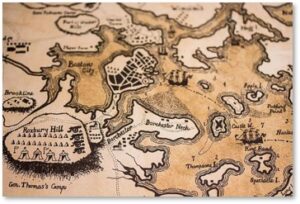At the end of Part 1, the heirs of John Hancock had begun carving the top off Beacon Hill and selling it for fill. But that didn’t end the presence of a beacon on the summit. Once again, let’s take a step back in time.
The Beacon and the Fort
In 1768, Boston’s citizens readied a new beacon on the summit of the hill in anticipation of the arrival of “peace-keeping troops.” Royal Governor Francis Bernard promptly removed the structure because he felt their concern was unwarranted.
Things changed by the spring of 1775, however. Surrounded by Provincial militiamen the British Regulars constructed a small fort atop Beacon Hill for observation. When they evacuated in March of 1776, Bostonians promptly re-built the beacon. This time they placed it at the center of the British fort. There it stood for 13 years, until a November storm brought it down in 1789.
The Memorial Column
Boston’s prominent architect, Charles Bulfinch, stepped in with a proposal to replace the beacon. He would erect a memorial column similar to those he had seen when traveling in Europe. In response, Bostonians took up a subscription for a memorial to the War for Independence eight years before the construction of the new State House.
Mr. Bulfinch designed the memorial from his four-acre estate located on the north side of the hill, near present-day Cambridge Street. A Doric column made of plaster on brick went up, mounted on a stone pedestal. A gilded wooden eagle “set up to serve as a weather vane” topped the 60-foot-high shaft. Four plaques on the pedestal commemorated the leading events of the American Revolution.
Bulfinch’s monument stood for twenty years and was taken down in 1811, when the top of Beacon Hill was removed for fill. In 1864, a committee formed to consider erecting a replacement column. The ongoing Civil War made resources difficult to come by, however.
The Second Monument
In 1898, The Bunker Hill Monument Association requested permission to erect an exact replica of the original column. The Legislature granted the association the right to rebuild the monument in a new place.
They also put the four memorial plaques, which had been preserved in the State House for over 100 years, at the association’s disposal.
The Bunker Hill Monument Association placed the new granite column100 feet east of the original location, if a tad lower. The original had been constructed, of course, at an elevation that no longer existed.
The association retrieved the original slate plaques from storage and incorporated them into the base of the new granite column. They dedicated the second Beacon Hill Monument on Bunker Hill Day, June 17, 1898. Its final cost came to $6,152.60. In today’s dollars, that would total $232,441.
Creating an Open Space
During the 1883 expansion of the State House, the State House Construction Committee took much land around the top of Beacon Hill by eminent domain. The legislature authorized the committee to take all property east of the new extension between Temple and Bowdoin Streets to provide an open space.
![]() In 1893 and 1894, the committee acquired more land for open space and laid out the whole area as an “ornamental park.” With that, we have almost reached the beginning of Ashburton Park—which we will get to in Part 3.
In 1893 and 1894, the committee acquired more land for open space and laid out the whole area as an “ornamental park.” With that, we have almost reached the beginning of Ashburton Park—which we will get to in Part 3.
But the next time you’re near the State House, take a look at that golden eagle atop his granite column. He marks where the top of Beacon Hill used to be—when it was 60 feet taller, much steeper, and more rural than today.



